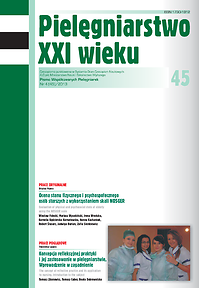Evaluation of physical and psychosocial state of elderly using the NOSGER scale
Keywords:
the elderly, the NOSGER scale, assessment of an elderly patientAbstract
EVALUATION OF PHYSICAL AND PSYCHOSOCIAL STATE OF ELDERLY USING THE NOSGER SCALE
Aim. The aim of the study was to asses physical and psycho-social state of the elderly staying in their home environments by means of the Nurses’ Observation Scale for Geriatric Patients (NOSGER).
Material and methods. The study was carried out among 132 elderly people, aged 65 and over, living in Lubelskie, Podkarpackie and Podlaskie Voivodeships. The research material was collected by means of the NOSGER scale, which enables both professional and amateur caregivers of elderly people to perform a prompt and easy assessment of their patients’ physical, mental and social condition. The scale consists of 30 questions and covers six fields: i.e. memory, instrumental activities of daily living (IADL), activities of daily living (ADL), moods and emotions, social behaviours, destructive, disruptive and antisocial behaviours.
Results. Having assessed patients by means of the NOSGER scale, 71.20% were included into the group described as the healthy subjects (they scored below 60 points), the group of the ill subjects comprised 28.80% of the total number (they scored over 60 points). Scores averaged at the level of 54.12, may be interpreted as an average level of psychosocial and physical fitness.
Conclusions. The NOSGER scale is a useful tool for assessing geriatric patients’ condition and allows specifying self-care deficiencies. Persons participating in the study proved to suffer from greatest functional ability deficiencies within instrumental everyday life activities. Those with higher education as well as the married people tended to enjoy greater fitness.
References
1. Michalska A, Łukowska A, Jachimowicz-Wołoszynek D. Opieka geriatryczna w Stanach Zjednoczonych – model PACE. Gerontol Pol. 2004; 12 (4): 169-171.
2. Doroszkiewicz H, Bień B. Podstawowa opieka geriatryczna na świecie. Pielęg XXI w. 2005; 1/2 (10/11): 93-97.
3. Strugała M, Talarska D. Wybrane aspekty opieki pielęgniarskiej nad seniorem w warunkach domu pomocy społecznej z uwzględnieniem funkcjonowania poznawczego i ryzyka rozwoju odleżyn. Fam Med Primary Care Rev. 2006; 8, 2: 336-340.
4. Wojszel BZ. Instrumenty pełnej oceny geriatrycznej – zastosowanie w praktyce lekarza rodzinnego. Gerontol Pol. 1997; 5 (1): 48-56.
5. Brunner C, Spiegel R. Eine Validierungsstudie mit der NOSGER (Nurses’ Observation Scale for Geratric Patients), einem neuen Beurteilungsinstrument für die Psychogeriatrie. Z Klin Psychol. 1990; 19, 3: 211-229.
6. Liszewska M. Zdążyć na czas. Senior z demencją a zastosowanie NOSGER (Nurses’ Observation Scale for Geratric Patients). Wspólne tematy. 2005; 1: 3-9.
7. Spiegel R, Brunner M, Ermini-Fünschilling D. i wsp. A new behavioral Assessment Scale for Geriatric Out- and In Patients: the NOSGER (Nurses’ Observation Scale for Geriatric Patients). J Am Geriatr Soc. 1991; 39 (4): 339-347.
8. Tremmel L, Spiegel R. Clinical experience with the NOSGER (Nurses’ Observation Scale for Geriatric Patients): tentative normative data and sensitivity to change. Int J Geriatr Psychiatry. 1993, vol. 8, 311-317.
9. Wahle M, Häller S, Spiegel R. Validation of the NOSGER (Nurses’ Observation Scale for Geriatric Patients): reliability and validity of a caregiver rating instrument. Int Psychogeriatr. 1996; vol. 8, 4: 525-547.
10. Fidecki W, Wysokiński M. Zastosowanie skali NOSGER w praktyce pielęgniarskiej. [w]: Kachaniuk H, red. Pielęgniarska opieka nad osobami starszymi. Dr Josef Raabe Spółka Wydawnicza Sp. z o.o, Warszawa 2008; s. 13-21.
11. Dziechciaż M, Płaszewska-Żywko L, Guty E. Samodzielność osób starszych mieszkających na wsi w zakresie podstawowych i złożonych czynności życiowych. Zdr Publ. 2010; 120 (4): 346-350
12. Pruszyński JJ, Cicha-Mikołajczyk A, Gębska-Kuczerowska A. Ocena wydolności czynnościowej i sprawności motorycznej osób przyjmowanych do pielęgniarskiego domu opieki w Polsce. Prz Epidemiol. 2006; 60: 331-338.
13. Płaszewska-Żywko L, Brzuzan P, Malinowska-Lipień I i wsp. Sprawność funkcjonalna u osób w wieku podeszłym w domach pomocy społecznej. Probl Hig Epid. 2008; 89 (1): 62-66.
14. Biercewicz M, Kędziora-Kornatowska K, Ślusarz R i wsp.: Ocena wydolności czynnościowej osób w wieku podeszłym na tle uwarunkowań zdrowotnych i społecznych. Pielęg XXI w. 2005; 1/2 (10/11): 39-45.
15. Worach-Kardas H. Starzenie się populacji jako wyznacznik potrzeb zdrowotnych i wyzwaniem dla zdrowia publicznego. Zdr Publ. 2006; 116 (1): 128-131.
16. Lewandowska A. Expectations of nursing homes pensioners. [w]: Olchowik G, red. Wellness in different phases of life. Lublin. Wyd. Neuro Centrum; 2008, s.115-119.
Downloads
Published
Issue
Section
License
Copyright (c) 2013 Wiesław Fidecki, Mariusz Wysokiński, Irena Wrońska, Kornelia Kędziora-Kornatowska, Hanna Kachaniuk, Robert Ślusarz, Jadwiga Burian, Zofia Sienkiewicz (Autor)

This work is licensed under a Creative Commons Attribution 4.0 International License.




